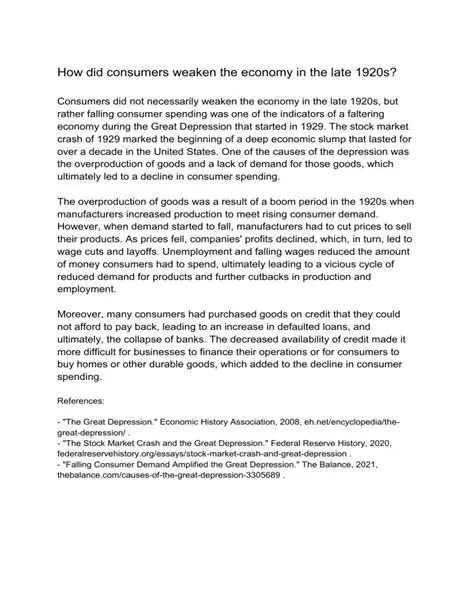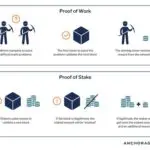The late 1920s marked a pivotal time in history, especially for the United States economy. It was a period of great prosperity, but it was also the prelude to the devastating Great Depression. In order to understand how the economy weakened during this time, it’s crucial to examine the role of consumer spending, excessive credit, overproduction, bank failures, and the ensuing domino effect of unemployment and poverty. These factors created a perfect storm that ultimately led to one of the most challenging economic crises in history. By delving into each of these subtopics, we can gain a deeper understanding of how consumer behavior and economic policies contributed to the decline, and learn valuable lessons that can be applied to modern economic challenges. Join us as we explore how consumer actions played a significant role in weakening the economy during the late 1920s.
Consumer Spending: The Catalyst for Economic Decline
Consumer spending plays a critical role in shaping the state of the economy. When consumers cut back on their spending, it can have a ripple effect on businesses, leading to a decline in production and ultimately resulting in economic downturn.
This decline in consumer spending can lead to a decrease in demand for goods and services, which in turn can lead to job losses and reduced income for businesses, causing a downward spiral in economic activity.
Excessive credit can also lead to a false sense of consumer spending, as individuals may borrow beyond their means, leading to financial instability and the potential for a collapse in spending habits.
It is important for policymakers and financial institutions to closely monitor and regulate consumer spending in order to prevent a catastrophic impact on the overall economy.
Excessive Credit: A Recipe for Disaster
When it comes to managing personal finances, it’s important to be mindful of the amount of credit we are taking on. While it may be tempting to take advantage of easy access to credit cards and loans, excessive credit can quickly become a recipe for disaster.
One of the main problems with excessive credit is the potential for high levels of debt. When individuals take on more credit than they can reasonably afford to pay back, they run the risk of falling into a cycle of debt that can be difficult to escape from. This can lead to financial stress, strained relationships, and overall decreased quality of life.
Furthermore, excessive credit can also have a negative impact on the overall economy. When large numbers of individuals and families are struggling with debt, consumer spending is likely to decrease, which can in turn lead to a decline in economic growth. This can create a ripple effect, impacting businesses, jobs, and investment opportunities.
It’s important for individuals to be aware of the potential consequences of excessive credit and to practice responsible borrowing. By being mindful of their credit limits and avoiding unnecessary debt, individuals can protect themselves from financial hardship and contribute to a more stable economy.
Overproduction: The Silent Crisis
Overproduction is a phenomenon that occurs when the supply of goods exceeds the demand for those goods. This can lead to a number of negative consequences for the economy, including price deflation, excess inventory, and ultimately, economic slowdown. When industries produce more goods than consumers are willing or able to purchase, it can result in a buildup of unsold goods and a decrease in prices, which can have a ripple effect throughout the economy.
This silent crisis can have far-reaching effects, impacting not only the producers of the goods, but also workers, consumers, and the overall health of the economy. Overproduction can lead to job losses as businesses scale back production in response to slowing demand. This, in turn, can erode consumer confidence and lead to a decrease in spending, further exacerbating the issue.
Furthermore, overproduction can also lead to a strain on resources and increased waste, as unsold goods may ultimately go to waste or be disposed of in environmentally damaging ways. The environmental impact of overproduction can be significant, with increased energy consumption, greenhouse gas emissions, and waste generation contributing to long-term ecological damage.
In order to address the silent crisis of overproduction, it is crucial for businesses to accurately gauge and respond to consumer demand, and for policymakers to implement measures that incentivize sustainable production and consumption. By taking proactive steps to mitigate overproduction, the economy can avoid the negative consequences of excess supply and work towards a more sustainable and balanced future.
Bank Failures: A Blow to the Economy
Bank failures can have a devastating impact on the economy, affecting not only the financial sector but also the wider economy. When banks fail, it can lead to a loss of confidence in the banking system, causing individuals and businesses to withdraw their funds, leading to a liquidity crisis. This can result in a credit crunch, making it difficult for businesses to access the funds they need to operate and grow.
Moreover, bank failures can also lead to a decrease in consumer spending. When people lose confidence in the banking system, they are less likely to spend money, leading to a decrease in demand for goods and services. This decline in consumer spending can have a ripple effect throughout the economy, leading to a slowdown in economic growth and a rise in unemployment.
Additionally, bank failures can also result in a domino effect, causing other financial institutions to come under strain. This can lead to a chain reaction of bank failures, further exacerbating the economic impact. Furthermore, the government may have to step in to bail out failing banks, diverting funds that could have been used for other important economic initiatives.
In conclusion, bank failures can have far-reaching consequences for the economy, impacting everything from consumer spending to unemployment. It is crucial for regulators and financial institutions to work together to prevent such failures and mitigate their impact on the broader economy.
The Domino Effect: Unemployment and Poverty
Unemployment and poverty are two interconnected issues that can trigger a series of negative consequences, creating a domino effect that can have a lasting impact on the economy and society as a whole.
When individuals are unable to find meaningful employment, they often struggle to make ends meet, leading to financial instability and a reduced quality of life. This can further exacerbate the cycle of poverty, as families are unable to afford basic necessities and are forced to make difficult choices regarding education, healthcare, and other essential needs. As a result, children growing up in these households may not have access to the resources and opportunities they need to break out of the cycle of poverty, perpetuating the problem for future generations.
Furthermore, high levels of unemployment can lead to a decrease in consumer spending, as individuals have less disposable income to contribute to the economy. This can then have a ripple effect, impacting businesses, leading to layoffs, and further contributing to the unemployment rate. As a result, the entire economic landscape can be destabilized, creating a pervasive sense of uncertainty and insecurity throughout society.
Ultimately, the domino effect of unemployment and poverty can have far-reaching implications, affecting not only the individuals directly impacted but also the broader economy and social fabric. It is therefore crucial for policymakers and communities to address these issues proactively, developing strategies to support job creation, provide access to essential resources, and break down the barriers that perpetuate the cycle of unemployment and poverty.
Frequently Asked Questions
What role did consumer spending play in the economic decline of the late 1920s?
Consumer spending played a significant role in the economic decline of the late 1920s as it contributed to overproduction and excessive credit, leading to a decrease in demand and economic instability.
How did excessive credit contribute to the economic decline in the late 1920s?
Excessive credit contributed to the economic decline in the late 1920s by encouraging irresponsible borrowing and spending, which ultimately led to a debt crisis and decreased consumer demand.
What impact did overproduction have on the economy in the late 1920s?
Overproduction had a detrimental impact on the economy in the late 1920s as it resulted in surplus goods, declining prices, and decreased profits for businesses, leading to economic instability and job losses.
How did bank failures affect the economy in the late 1920s?
Bank failures had a significant impact on the economy in the late 1920s as they led to a loss of savings, decreased confidence in the banking system, and a reduction in the availability of credit, further exacerbating the economic downturn.
What was the relationship between unemployment and poverty in the late 1920s?
The relationship between unemployment and poverty in the late 1920s was closely intertwined, as high levels of unemployment resulted in widespread poverty, decreased consumer spending, and a further weakening of the economy.
How did consumer spending, excessive credit, overproduction, and bank failures contribute to the domino effect in the late 1920s?
Consumer spending, excessive credit, overproduction, and bank failures collectively contributed to a domino effect in the late 1920s, leading to decreased demand, job losses, poverty, and a widespread economic downturn.
What lessons can be learned from the consumer-driven economic decline of the late 1920s?
The consumer-driven economic decline of the late 1920s serves as a cautionary tale about the potential consequences of excessive credit, overproduction, and unsustainable consumer spending, highlighting the importance of responsible financial practices and economic policies.







